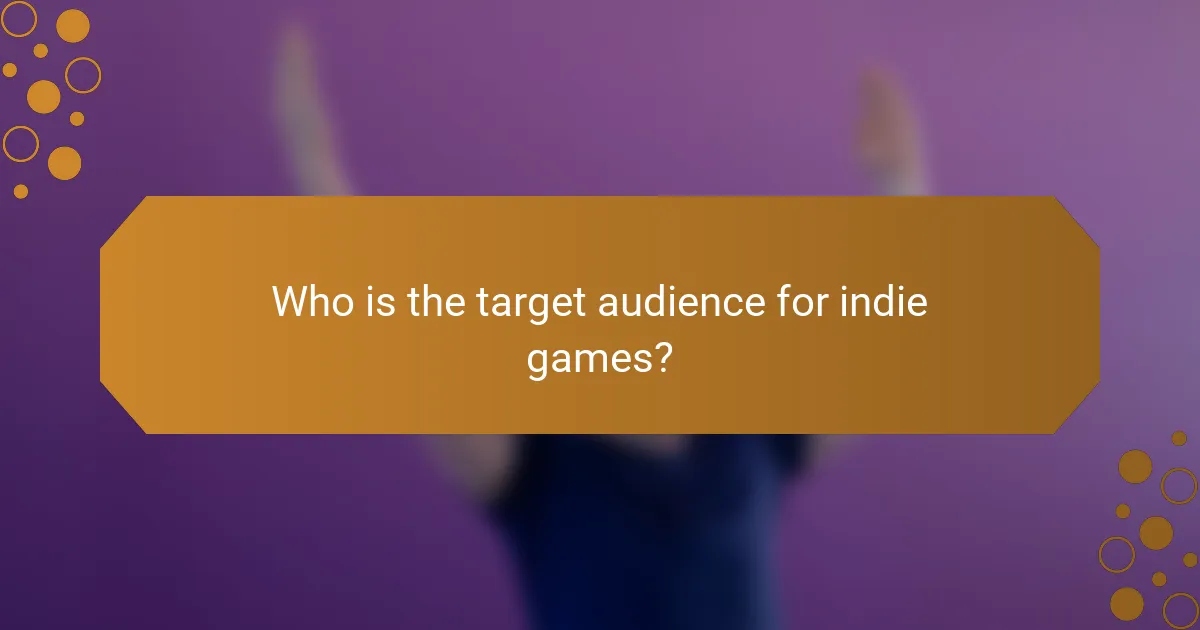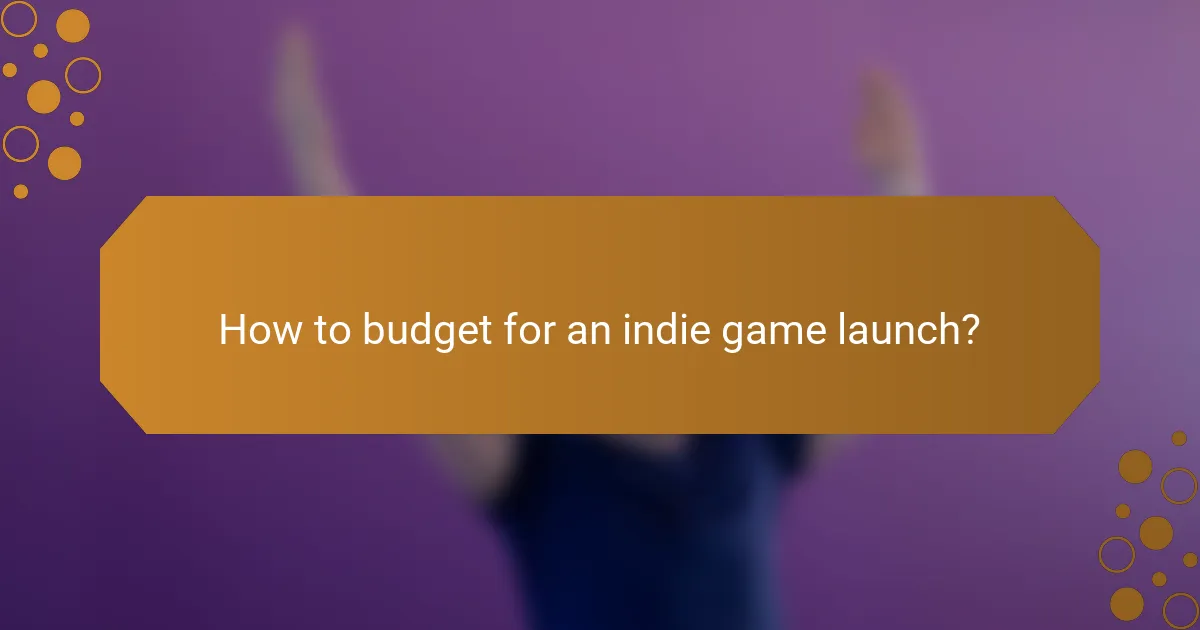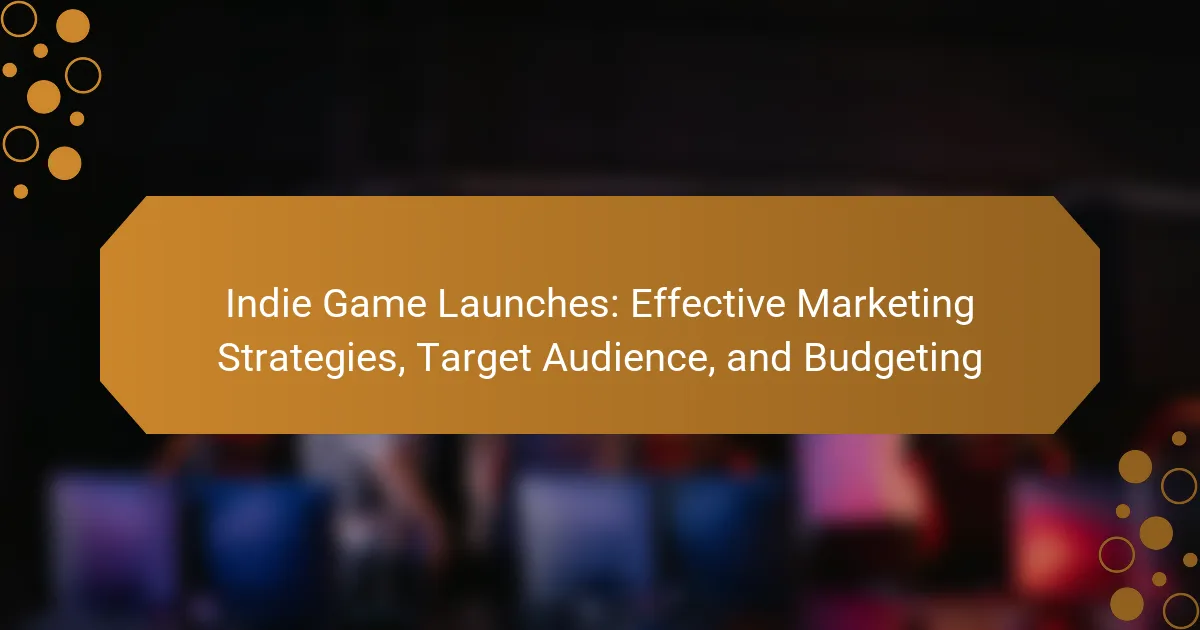Launching an indie game successfully requires a strategic approach to marketing that includes social media engagement, influencer partnerships, and community interaction. By understanding the diverse target audience and their preferences, developers can tailor their marketing efforts to resonate with potential players. Additionally, careful budgeting is essential to allocate resources effectively across marketing, development, and post-launch support, ensuring maximum visibility and success in a competitive landscape.

What are effective marketing strategies for indie game launches?
Effective marketing strategies for indie game launches include leveraging social media, forming partnerships with influencers, utilizing email marketing, engaging with the community, and creating compelling content. These approaches help build awareness, attract players, and drive sales in a competitive market.
Social media campaigns
Social media campaigns are crucial for indie game launches as they provide a platform to reach a broad audience. Focus on platforms like Twitter, Instagram, and TikTok, where gamers frequently engage. Create visually appealing posts, share behind-the-scenes content, and use relevant hashtags to increase visibility.
Consider running targeted ads to reach specific demographics, such as age groups or gaming preferences. Allocate a budget that allows for experimentation, typically starting with a few hundred dollars to gauge effectiveness.
Influencer partnerships
Partnering with influencers can significantly amplify your game’s reach. Identify influencers who align with your game’s genre and audience, and approach them with a clear value proposition. Offering free game keys or exclusive content can incentivize them to promote your game.
Micro-influencers, who have smaller but highly engaged followings, can often provide a better return on investment compared to larger influencers. Establish clear expectations and deliverables to ensure a successful collaboration.
Email marketing
Email marketing remains a powerful tool for indie game launches, allowing direct communication with potential players. Build an email list through your website or social media platforms by offering incentives like exclusive content or early access to the game.
Craft engaging newsletters that include updates, launch dates, and sneak peeks. Aim for a frequency that keeps your audience informed without overwhelming them, typically one to two emails per month leading up to the launch.
Community engagement
Engaging with the gaming community is essential for fostering loyalty and excitement around your game. Participate in forums, Discord servers, and Reddit communities relevant to your game’s genre. Share progress updates and solicit feedback to create a sense of ownership among potential players.
Hosting events like Q&A sessions or live streams can also enhance community interaction. Be responsive to comments and suggestions to build trust and rapport with your audience.
Content marketing
Content marketing helps establish your game’s identity and attracts players through valuable information. Create blog posts, videos, and tutorials that highlight game features, development stories, or gameplay strategies. This content can improve your search engine visibility and draw in organic traffic.
Consider collaborating with gaming websites or blogs to guest post or feature your game. This can expand your reach and introduce your game to new audiences, enhancing overall visibility before the launch.

Who is the target audience for indie games?
The target audience for indie games typically includes a diverse range of players, each with unique preferences and gaming habits. Understanding these segments helps developers tailor their marketing strategies effectively.
Casual gamers
Casual gamers are individuals who play games for relaxation and entertainment rather than competition. They often prefer simple mechanics and shorter play sessions, making mobile platforms and easy-to-learn titles appealing.
To attract casual gamers, indie developers should focus on intuitive gameplay, engaging visuals, and social features that encourage sharing and community interaction. Examples include puzzle games and light-hearted adventures that can be enjoyed in short bursts.
Hardcore gamers
Hardcore gamers are dedicated players who seek depth, challenge, and complex narratives in their gaming experiences. They often invest significant time into mastering games and appreciate high-quality graphics and intricate gameplay mechanics.
Indie titles targeting hardcore gamers should emphasize unique gameplay elements, rich storytelling, and replayability. Games like roguelikes or intricate RPGs can resonate well with this audience, as they offer the depth and challenge hardcore gamers crave.
Genre-specific enthusiasts
Genre-specific enthusiasts are players who have a strong preference for particular game genres, such as platformers, shooters, or simulation games. They are often well-informed about the latest trends and innovations within their favorite genres.
To effectively reach genre-specific enthusiasts, indie developers should highlight unique features and innovations in their games. Engaging with communities on platforms like forums or social media can also help build a loyal following among these players.
Age demographics
Age demographics play a crucial role in defining the target audience for indie games. Younger players, often in their teens and twenties, may prefer fast-paced, visually appealing games, while older players might gravitate towards nostalgic titles or games with deeper narratives.
Indie developers should consider age-related preferences when designing their marketing strategies. For example, games aimed at younger audiences might benefit from vibrant graphics and social media marketing, whereas titles for older players could focus on storytelling and emotional engagement. Understanding these nuances can enhance outreach and player retention.

How to budget for an indie game launch?
Budgeting for an indie game launch involves carefully planning your financial resources across various aspects of marketing, development, and post-launch support. A well-structured budget ensures that you allocate funds effectively to maximize your game’s visibility and success.
Marketing budget allocation
When allocating your marketing budget, consider a range of 20-30% of your total budget for promotional activities. This includes expenses for social media advertising, influencer partnerships, and promotional events.
Prioritize platforms where your target audience is most active. For instance, if your game appeals to younger gamers, focus on platforms like TikTok and Twitch. Create a detailed plan that outlines specific campaigns and their expected costs to avoid overspending.
Development costs
Development costs can vary significantly based on the complexity of your game. Indie games typically range from a few thousand to several hundred thousand dollars, depending on factors like art assets, programming, and sound design.
Break down your development budget into categories such as software licenses, salaries for team members, and outsourcing costs. Keep a contingency fund of about 10-15% to cover unexpected expenses that may arise during the development process.
Post-launch support expenses
Post-launch support is crucial for maintaining player engagement and addressing issues. Allocate around 10-20% of your budget for ongoing support, including server costs, updates, and community management.
Consider setting aside funds for bug fixes and new content to keep players interested. Regular updates can enhance player retention and encourage positive reviews, which are vital for long-term success.

What are the prerequisites for a successful indie game launch?
A successful indie game launch requires careful planning and execution across several key areas. Focusing on game quality assurance, market research, and branding consistency can significantly enhance your chances of success.
Game quality assurance
Quality assurance (QA) is crucial for ensuring that your game is free from bugs and offers a smooth user experience. Conduct thorough testing across different devices and platforms to identify and fix issues before launch.
Consider using both automated testing tools and manual testing by real players to gather diverse feedback. Aim for a minimum of several weeks of QA to address any critical problems that could affect gameplay.
Market research
Understanding your target audience is essential for a successful launch. Conduct market research to identify player preferences, trends, and competitors in your genre. Utilize surveys, social media polls, and forums to gather insights.
Analyze data from similar games to determine effective pricing strategies and marketing channels. This research can help you tailor your game and promotional efforts to better meet the expectations of potential players.
Branding consistency
Maintaining branding consistency across all platforms and materials is vital for building recognition and trust. Ensure your game’s visual identity, messaging, and tone are uniform in trailers, social media, and promotional content.
Develop a style guide that outlines your branding elements, including logos, color schemes, and typography. This guide will help keep your marketing materials cohesive and strengthen your game’s presence in a crowded market.

How to measure the success of an indie game launch?
Measuring the success of an indie game launch involves analyzing various metrics that reflect sales performance and user engagement. Key indicators include sales figures, player retention rates, and community feedback, which together provide a comprehensive view of how well the game is performing in the market.
Sales metrics
Sales metrics are crucial for assessing the financial success of your indie game. Track total units sold, revenue generated, and average revenue per user (ARPU) to gauge performance. A good starting point is to aim for a sales target that covers your development and marketing costs within the first few months post-launch.
Consider using platforms like Steam or itch.io, which provide sales data and insights into player demographics. Comparing your sales against similar indie titles can help contextualize your performance. For instance, achieving sales in the low thousands within the first month can be a positive sign for many indie developers.
User engagement statistics
User engagement statistics reveal how players interact with your game and can indicate long-term success. Key metrics include daily active users (DAU), session length, and player retention rates over time. High engagement often correlates with positive word-of-mouth and community growth.
To effectively measure engagement, utilize analytics tools that track player behavior. For example, a retention rate of 30% after the first week is generally considered strong for indie games. Regularly updating your game and engaging with your community can further enhance these metrics, leading to sustained interest and sales.
